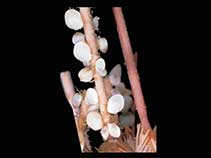Lissarca notorcadensis Meville & Standen, 1907
| Native range | All suitable habitat | Point map | Year 2050 |

|
| This map was computer-generated and has not yet been reviewed. |
| Lissarca notorcadensis AquaMaps Data sources: GBIF OBIS |
Classification / Names Common names | Synonyms | CoL | ITIS | WoRMS
Bivalvia | Arcida | Philobryidae
Environment: milieu / climate zone / depth range / distribution range Ecology
Benthic; depth range 0 - 1890 m (Ref. 124196). Polar; 53°S - 79°S, 180°W - 180°E
Distribution Countries | FAO areas | Ecosystems | Occurrences | Introductions
Southwest Atlantic and the Antarctic.
Length at first maturity / Size / Weight / Age
Maturity: Lm ?, range 1 - ? cm Max length : 0.6 cm TL male/unsexed; (Ref. 7875); common length : 0.3 cm TL male/unsexed; (Ref. 7875)
Life cycle and mating behavior Maturity | Reproduction | Spawning | Eggs | Fecundity | Larvae
Life cycle: Fertilization occurs in the mantle cavity after the release of mature eggs in the early austral summer or late spring. Females dominate males in number during summer which is when females are brooding (early stage) nonshelled embryos in the infrabranchial chamber. Shell development begins during late summer and early autumn with simultaneous development of ova, i.e., females may simultaneously carry eggs and brood larvae. Males dominate females in number during late autumn and early winter, it is also when the ova are fully developed. Shelled juveniles are released in late winter to early summer. Egg and embryo development takes 2 years (Refs. 833, 72610, 105049).
Main reference
References | Coordinator | Collaborators
SAUP Database. 2006. (Ref. 356)
IUCN Red List Status (Ref. 130435)
CITES status (Ref. 108899)
Not Evaluated
CMS (Ref. 116361)
Not Evaluated
Threat to humans
Harmless
Human uses
| FishSource |
Tools
More information
Internet sources
BHL | BOLD Systems | CISTI | DiscoverLife | FAO(Publication : search) | Fishipedia | GenBank (genome, nucleotide) | GloBI | Gomexsi | Google Books | Google Scholar | Google | PubMed | Tree of Life | Wikipedia (Go, Search) | Zoological Record
Estimates based on models
Preferred temperature
(Ref. 115969): -1.5 - 1.4, mean -0.5 (based on 473 cells).
Resilience
(Ref. 69278):
Low, minimum population doubling time 4.5 - 14 years (K=0.09-0.11).
Price category
(Ref. 80766):
Unknown.



